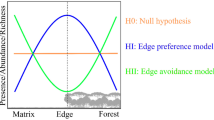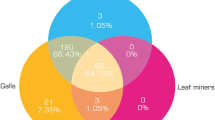Abstract
Significant worldwide interest in conservation biological control in agricultural systems currently exists but little information is available on the usefulness of this approach in farm forestry. In a field experiment conducted in a native vegetated shelterbelt in central-west New South Wales, we measured the diversity of wasps in plots comprising Eucalyptus blakelyi Maiden (Myrtaceae) trees with and without a groundcover of Lobularia maritima (L.) Desv. (Brassicaceae). Vacuum samples revealed a greater abundance and species richness of parasitic wasps in the plots comprising trees surrounded by the L. maritima groundcover. Cotesia sp. (Hymenoptera: Braconidae), Pteromalus sp. (Hymenoptera: Pteromalidae), Anagyrus sp. (Hymenoptera: Encyrtidae), Entedoninae sp. and Eulophidae sp. 1 (Hymenoptera: Eulophidae) were the most common taxa. These were more abundant also in the trees with the L. maritima groundcover. Ardozyga stratifera (Meyrick) (Lepidoptera: Gelechiidae) larvae, that were naturally infesting the E. blakelyi trees, were significantly more parasitized in the trees with the L. maritima groundcover. Results indicate that parasitic wasps associated with a native-tree shelterbelt in Australia were amenable to manipulation via groundcover vegetation.

Similar content being viewed by others
References
Ambrosino MD, Luna JM, Jepson PC, Wratten SD (2006) Relative frequencies of visits to selected insectary plants by predatory hoverflies (Diptera: Syrphidae), other beneficial insects, and herbivores. Environ Entomol 35:394–400
Austin AD, Yeates DK, Cassis G, Fletcher MJ, La Salle J, Lawrence JF, McQuillan PB, Mound LA, Bickel DJ, Gullan PJ, Hales DF, Taylor GS (2004) Insects ‘Down Under’—diversity, endemism and evolution of the Australian insect fauna: examples from select orders. Aust J Entomol 43:216–234
Austin AD, Johnson NF, Dowton M (2005) Systematics, evolution and biology of scelionid and platygastrid wasps. Annu Rev Entomol 50:553–582
Baggen LR, Gurr GM (1998) The influence of food on Copidosoma koehleri (Hymenoptera: Encyrtidae), and the use of flowering plants as a habitat management tool to enhance biological control of potato moth, Phthorimaea operculella (Lepidoptera: Gelechiidae). Biol Control 11:9–17
Baudry J, Bunce RGH, Burel F (2000) Hedgerows: an international perspective on their origin, function and management. J Environ Manage 60:7–22
Begum M, Gurr GM, Wratten SD, Hedberg P, Nicol HI (2006) Using selective food plants to maximize biological control of vineyard pests. J Appl Ecol 43:547–554
Bell VA, Brightwell RJ, Lester PJ (2006) Increasing vineyard floral resources may not enhance localized biological control of the leafroller Epiphyas postvittana (Lepidoptera: Tortricidae) by Dolichogenidea spp. (Hymenoptera: Braconidae) parasitoids. Biocontrol Sci Technol 16:1031–1042
Berndt LA, Wratten SD, Hassan P (2002) Effects of buckwheat flowers on leafroller (Lepidoptera: Tortricidae) parasitoids in a New Zealand vineyard. Agric For Entomol 4:39–45
Bianchi FJJA, van Wingerden WKRE, Griffioen AJ, van der Veen M, van der Straten MJJ, Wegman RMA, Meeuwsen HAM (2005) Landscape factors affecting the control of Mamestra brassicae by natural enemies in Brussels sprout. Agric Ecosyst Environ 107:145–150
Bianchi FJJA, Booij CJH, Tscharntke T (2006) Sustainable pest regulation in agricultural landscapes: a review on landscape composition, biodiversity and natural pest control. Proc R Soc Lond B Biol Sci 273:1715–1727
Billeter R, Liira J, Bailey D, Bugter R, Arens P, Augenstein I, Aviron S, Baudry J, Bukacek R, Burel F, Cerny M, De Blust G, De Cock R, Diekötter T, Dietz H, Dirksen J, Dormann C, Durka W, Frenzel M, Hamersky R, Hendrickx F, Herzog F, Klotz S, Koolstra B, Lausch A, Le Coeur E, Maelfait JP, Opdam P, Roubalova M, Schermann A, Schermann N, Schmidt T, Schweiger O, Smulders MJM, Speelmans M, Simova P, Verboom J, van Windergen WKRE, Zobel M, Edwards PJ (2008) Indicators for biodiversity in agricultural landscapes: a pan-European study. J Appl Ecol 45:141–150
Bostanian NJ, Goulet H, O’Hara J, Masner L, Racette G (2004) Towards insecticide free apple orchards: flowering plants to attract beneficial arthropods. Biocontrol Sci Technol 14:25–37
Bugg RL, Waddington D (1994) Using cover crops to manage arthropod pests of orchards: a review. Agric Ecosyst Environ 50:11–28
Common IFB (1990) Moths of Australia. Melbourne University Press, Australia
CSIRO (1996) Insect pests of eucalypts of farmland and in plantations in southeastern Australia. Australia Identification Leaflet Series, Leaflets 1-15, CSIRO Publishing, Collingwood, Victoria, Australia
DeBach P (1964) The scope of biological control. In: DeBach P (ed) Biological control of insect pests and weeds. Chapman and Hall, London, UK, pp 3–20
Dennis P, Thomas MB, Sotherton NW (1994) Structural features of field boundaries which influence the overwintering densities of beneficial arthropod predators. J Appl Ecol 31:361–370
Dix ME, Leatherman D (1988) Insect management in windbreaks. Agric Ecosyst Environ 22(23):513–537
Ehler LE (1998) Conservation biological control: past, present, and future. In: Barbosa P (ed) Conservation biological control. Academic Press, USA, pp 1–8
Fernandes OA, Wright RJ, Baumgarten KH, Mayo ZB (1997) Use of rubidium to label Lysiphlebus testaceipes (Hymenoptera: Braconidae), a parasitoid of green bugs (Homoptera: Aphididae), for dispersal studies. Environ Entomol 26:1167–1172
Fiedler AK, Landis DA, Wratten SD (2008) Maximizing ecosystem services from conservation biological control: the role of habitat management. Biol Control 45:254–271
Fitzgerald JD, Solomon MG (2004) Can flowering plants enhance numbers of beneficial arthropods in UK apple and pear orchards? Biocontrol Sci Technol 14:291–300
Freeman-Long R, Corbett A, Lamb C, Reberg-Horton C, Chandler J, Stimmann M (1998) Beneficial insects move from flowering plants to nearby crops. Calif Agric September–October:23–26
Gámez-Virués S, Bonifacio RS, Gurr GM, Kinross C, Raman A, Nicol HI (2007) Arthropod prey of shelterbelt-associated birds: linking faecal samples with biological control of agricultural pests. Aust J Entomol 46:335–341
Gauld ID (1984) An introduction to the Ichneumonidae of Australia. British Museum (Natural History), London, UK
Heimpel GE, Jervis MA (2005) Does floral nectar improve parasitoid efficacy? In: Wäckers FL, van Rijn PCJ, Bruin J (eds) Plant-provided food for carnivorous insects: a protective mutualism and its applications. Cambridge University Press, Cambridge, UK, pp 267–304
Irvin NA, Wratten SD, Frampton CM, Chapman RB, Tylianakis JM (2000) Understory management for the enhancement of the leafroller parasitoid Dolichogenidea tasmanica (Cameron) in orchards at Canterbury, New Zealand. In: Austin AD, Dowton M (eds) Hymenoptera: evolution biodiversity and biological control. CSIRO Publishing, Collingwood, VIC, Australia, pp 396–403
Irvin NA, Scarratt SL, Wratten SD, Frampton CM, Chapman RB, Tylianakis JM (2006) The effects of floral understoreys on parasitism of leafrollers (Lepidoptera: Tortricidae) on apples in New Zealand. Agric For Entomol 8:25–34
Jacob HS, Evans EW (2004) Influence of different sugars on the longevity of Bathyplectes curculionis (Hym., Ichneumonidae). J Appl Entomol 128:316–320
Jervis MA, Kidd NAC, Heimpel GE (1996) Parasitoid adult feeding and biological control: a review. Biocontrol News Inf 17:1N–22N
Johanowicz DL, Mitchell ER (2000) Effects of sweet alyssum flowers on the longevity of the parasitoid wasps Cotesia marginiventris (Hymenoptera: Braconidae) and Diadegma insulare (Hymenoptera: Ichneumonidae). Fla Entomol 83:41–47
Kruess A, Tscharntke T (1994) Habitat fragmentation, species loss, and biological control. Science 264:1581–1584
Kruess A, Tscharntke T (2000) Species richness and parasitism in a fragmented landscape: experiments and field studies with insects on Vicia sepium. Oecologia 122:129–137
La Salle J (2004) Biology of gall inducers and evolution of gall induction in Chalcidoidea (Hymenoptera: Eulophidae, Eurytomidae, Pteromalidae, Tanaostigmatidae, Torymidae). In: Raman A, Schaeffer CW, Withers TM (eds) Biology, ecology and evolution of gall-inducing arthropods. Science Publishers, Enfield, USA, pp 507–537
Lavandero B, Wratten S, Shishehbor P, Worner S (2005) Enhancing the effectiveness of the parasitoid Diadegma semiclausum (Helen): movement after use of nectar in the field. Biol Control 34:152–158
Loch AD, Floyd RB (2001) Insect pests of Tasmanian blue gum, Eucalyptus globulus globulus, in southwestern Australia: history, current perspectives and future prospects. Austral Ecol 26:458–466
Magurran AE (1988) Ecological diversity and its measurement. Croom Helm, London
Majer JD, Recher H, Keals N (2000) Canopy arthropod faunas in fragmented agricultural landscapes. In: Hobbs RJ, Yates CJ (eds) Temperate eucalypt woodlands in Australia. Surrey Beatty & Sons Pty Limited and The Royal Australasian Ornithologists Union, Chipping Norton, NSW, Australia, pp 235–247
Marino PC, Landis DL (1996) Effect of landscape structure on parasitoid diversity and parasitism in agroecosystems. Ecol Appl 6:276–284
Naumann ID (1991) Hymenoptera. The insects of Australia, vol 2, 2nd edn. Merlbourne University Press, Carlton, Australia, pp 916–1000
Nicholls CI, Parrella M, Altieri MA (2001) The effects of a vegetational corridor on the abundance and dispersal of insect biodiversity within a northern California organic vineyard. Landscape Ecol 16:133–146
Olson DM, Wäckers FL (2007) Managements of field margins to maximize multiple ecological services. J Appl Ecol 44:13–21
Pasek JE (1988) Influence of wind and windbreaks on local dispersal of insects. Agric Ecosyst Environ 22(23):539–554
Pollard KA, Holland JM (2006) Arthropods within the woody element of hedgerows and their distribution pattern. Agric For Entomol 8:203–211
Pontin DR, Wade MR, Kehrli P, Wratten SD (2006) Attractiveness of single and multiple species flower patches to beneficial insects in agroecosystems. Ann Appl Biol 148:39–47
Raven PH, Yeates DK (2007) Australian biodiversity: threats for the present, opportunities for the future. Aust J Entomol 46:177–187
Short MW, Steinbauer MJ (2004) Floral nectar versus honeydew as food for wasp parasitoids: implications for pest management in eucalypt plantations. Aust For 67:199–203
Siemann E, Tilman D, Haarstad J, Ritchie M (1998) Experimental tests of the dependence of arthropod diversity on plant diversity. Am Nat 152:738–750
Sivinski J, Aluja M, Holler T (2006) Food sources for adult Diachasmimorpha longicaudata, a parasitoid of tephritid fruit flies: effects on longevity and fecundity. Entomol Exp Appl 118:193–202
Steffan-Dewenter I, Müzenberg U, Tscharntke T (2001) Pollination, seed set, and seed predation on a landscape scale. Proc R Soc Lond B Biol Sci 268:1685–1690
Stephens MJ, France CM, Wratten SD, Frampton C (1998) Enhancing biological control of leafrollers (Lepidoptera: Tortricidae) by sowing buckwheat (Fagopyrum esculentum) in an orchard. Biocontrol Sci Technol 8:547–558
Stephens C, Schellhorn NA, Wood GM, Austin AD (2006) Parasitic wasp assemblages associated with native and weedy plant species in an agricultural landscape. Aust J Entomol 45:176–184
Stevens NB, Stephens CJ, Iqbal M, Jennings JT, La Salle J, Austin AD (2007) What wasp is that? [cd-rom]: an interactive identification guide to the Australian families of Hymenoptera. Australian Biological Resources Study and Centre for Biological Information Technology (ABRS identification series), Canberra, ACT, Dewey Number: 595.79099
Thies C, Steffan-Dewenter I, Tscharntke T (2003) Effects of landscape context on herbivory and parasitism at different spatial scales. Oikos 101:18–25
Thomas CFG, Marshall EJP (1999) Arthropod abundance and diversity in differently vegetated margins of arable fields. Agric Ecosyst Environ 72:131–144
Thomas MB, Wratten SD, Sotherton NW (1991) Creation of ‘island’ habitats in farmland to manipulate populations of beneficial arthropods: predator densities and emigration. J Appl Ecol 28:906–917
Thomas MB, Wratten SD, Sotherton NW (1992) Creation of ‘island’ habitats in farmland to manipulate populations of beneficial arthropods: predator densities and species composition. J Appl Ecol 29:524–531
Tsitsilas A, Stuckey S, Hoffmann AA, Weeks AR, Thomson LJ (2006) Shelterbelts in agricultural landscapes suppress invertebrate pests. Aust J Exp Agr 46:1379–1388
Vattala HD, Wratten SD, Phillips CB, Wäckers FL (2006) The influence of flower morphology and nectar quality on the longevity of a parasitoid biological control agent. Biol Control 39:179–185
Woodcock BA, Westbury DB, Potts SG, Harris SJ, Brown VK (2005) Establishing field margins to promote beetle conservation in arable farms. Agric Ecosyst Environ 107:255–266
Acknowledgements
We thank Andrew Mitchell (Orange Agriculture Institute, NSW) and Ted Edwards (Australian National Insect Collection, CSIRO, Canberra) for confirming Ardozyga stratifera (Lepidoptera); Matthew Buffington (USDA/SEL, Washington) for determining Figitidae and Cynipidae (Hymenoptera); Andrew Austin (The University of Adelaide, SA) for determining Glyptapanteles sp. (Hymenoptera: Braconidae); and Marja Simpson for help in field work. This study was supported by the Joint Venture Agroforestry Program [Project # US-117A] and Australian National Field Days, NSW, Australia.
Author information
Authors and Affiliations
Corresponding author
Additional information
Handling editor: Torsten Meiners.
Rights and permissions
About this article
Cite this article
Gámez-Virués, S., Gurr, G., Raman, A. et al. Effects of flowering groundcover vegetation on diversity and activity of wasps in a farm shelterbelt in temperate Australia. BioControl 54, 211–218 (2009). https://doi.org/10.1007/s10526-008-9182-9
Received:
Accepted:
Published:
Issue Date:
DOI: https://doi.org/10.1007/s10526-008-9182-9




